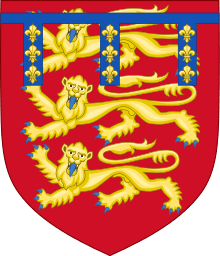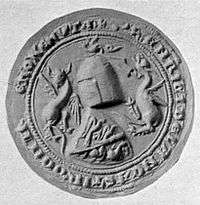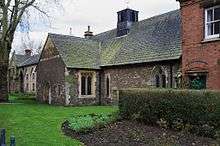Henry, 3rd Earl of Lancaster
| Henry of Lancaster | |
|---|---|
| Earl of Lancaster and Leicester | |
 Later arms of Henry of Lancaster: The royal arms of King Henry III a label France of three points | |
| Earl of Lancaster and Leicester | |
| Predecessor | Thomas, 2nd Earl |
| Successor | Henry of Grosmont, 4th Earl, later 1st Duke of Lancaster |
| Born | c. 1281 |
| Died |
22 September 1345 (aged c. 63–64) Leicester Castle |
| Spouse | Maud Chaworth |
| Issue |
Henry of Grosmont, 1st Duke of Lancaster Blanche of Lancaster, Baroness Wake of Liddell Maud of Lancaster, Countess of Ulster Joan of Lancaster, Baroness Mowbray Isabel of Lancaster, Prioress of Amesbury Eleanor of Lancaster, Countess of Arundel Mary of Lancaster, Baroness Percy |
| House | Plantagenet |
| Father | Edmund Crouchback, 1st Earl of Lancaster |
| Mother | Blanche of Artois |

Henry, 3rd Earl of Leicester and Lancaster (c. 1281 – 22 September 1345) was a grandson of King Henry III (1216-1272) of England and was one of the principals behind the deposition of King Edward II (1307-1327), his first cousin.
Origins
He was the younger son of Edmund Crouchback, 1st Earl of Lancaster, Earl of Leicester,[1] a son of King Henry III by his wife Eleanor of Provence. Henry's mother was Blanche of Artois, Queen Dowager of Navarre.
Henry's elder brother Thomas, 2nd Earl of Lancaster, succeeded their father in 1296, but Henry was summoned to Parliament on 6 February 1298/99 by writ directed to Henrico de Lancastre nepoti Regis ("Henry of Lancaster, nephew of the king", Edward I), by which he is held to have become Baron Lancaster. He took part in the Siege of Caerlaverock in July 1300.
Petition for succession and inheritance
After a period of longstanding opposition to King Edward II and his advisors, including joining two open rebellions, Henry's brother Thomas was convicted of treason, executed and had his lands and titles forfeited in 1322. Henry did not participate in his brother's rebellions; he later petitioned for his brother's lands and titles, and on 29 March 1324 he was invested as Earl of Leicester. A few years later, shortly after his accession in 1327, the young Edward III of England returned the earldom of Lancaster to him, along with other lordships such as that of Bowland.
Revenge
On the Queen's return to England in September 1326 with Roger Mortimer, 1st Earl of March, Henry joined her party against King Edward II, which led to a general desertion of the king's cause and overturned the power of Hugh le Despenser, 1st Earl of Winchester, and his namesake son Hugh the younger Despenser.
He was sent in pursuit and captured the king at Neath in South Wales. He was appointed to take charge of the king and was responsible for his custody at Kenilworth Castle.
Full restoration and reward
Henry was appointed "chief advisor" for the new king Edward III of England,[2] and was also appointed captain-general of all the king's forces in the Scottish Marches.[3] He was appointed Constable of Lancaster Castle and High Sheriff of Lancashire in 1327. He also helped the young king to put an end to Mortimer's regency and tyranny, also had him declared a traitor and executed in 1330.
Loss of sight
In about the year 1330, he became blind.
Later life and death
Henry spent the last fifteen years of his life at Leicester Castle. There he founded a hospital for the poor and infirm in an extension of the castle bailey. It became known as the Newarke, and Henry was buried in the hospital chapel when he died in 1345. The king and queen attended his funeral. His son Henry of Grosmont, first Duke of Lancaster, had his father's remains moved to the collegiate Church of the Annunciation of Our Lady of the Newarke, which he had built when he enhanced his father's foundation.[4][5]

Nickname
According to Froissart, he was nicknamed Wryneck, or Tort-col in French, possibly due to a medical condition.
Succession
He was succeeded as Earl of Lancaster and Leicester by his eldest son, Henry of Grosmont, who subsequently became Duke of Lancaster.
Issue
He married Maud Chaworth, before 2 March 1296/1297.[6]
Henry and Maud had seven children:
- Henry, Earl of Derby, (about 1300–1360/61)
- Blanche of Lancaster, (about 1305–1380) married Thomas Wake, 2nd Baron Wake of Liddell
- Matilda of Lancaster, (about 1310–1377); married William de Burgh, 3rd Earl of Ulster and had descendants.
- Joan of Lancaster, (about 1312–1345); married John de Mowbray, 3rd Baron Mowbray and had descendants
- Isabel of Lancaster, Abbess of Amesbury, (about 1317-after 1347)
- Eleanor of Lancaster, (about 1318–1371/72) married (1) John De Beaumont and (2) 5 Feb. 1344/5, Richard FitzAlan, 10th Earl of Arundel and had descendants
- Mary of Lancaster, (about 1320–1362), who married Henry de Percy, 3rd Baron Percy, and was the mother of Henry Percy, 1st Earl of Northumberland.
Titles, styles, honours and arms
Arms
Prior to his restoration to his earldoms, Henry bore the royal arms of King Henry III, differenced by a bend azure. Upon his restoration, his difference changed, to a label France of three points (that is to say a label of three points azure each charged with three fleur-de-lys or.[7]
 Shield prior to restoration
Shield prior to restoration Shield as Earl of Lancaster and Leicester
Shield as Earl of Lancaster and Leicester
Ancestry
| Ancestors of Henry, 3rd Earl of Lancaster | ||||||||||||||||||||||||||||||||||||||||||||||||||||||||||||||||||||||||||||||||||||||||||||||||||||||||||||||||||||||||||||||||||||||||||||||||||||||||||||||||||||||||||||||||||||||||||||||||||||||||||||||||||||||||||||||||||||||||||||||||||||||||||||||||||||||||||||||||||||||||||||||||||||||||||||||||||||||||||||||||||||||||||||||||||||||||||||||||||||||||||||||||||||||||||||||||||||||||||||||||||||||||||||||||||||||||||||||||||||||||||||||||||||||||||||||||||||||||||||||||||||||||||||||||||||||||||||||||||
|---|---|---|---|---|---|---|---|---|---|---|---|---|---|---|---|---|---|---|---|---|---|---|---|---|---|---|---|---|---|---|---|---|---|---|---|---|---|---|---|---|---|---|---|---|---|---|---|---|---|---|---|---|---|---|---|---|---|---|---|---|---|---|---|---|---|---|---|---|---|---|---|---|---|---|---|---|---|---|---|---|---|---|---|---|---|---|---|---|---|---|---|---|---|---|---|---|---|---|---|---|---|---|---|---|---|---|---|---|---|---|---|---|---|---|---|---|---|---|---|---|---|---|---|---|---|---|---|---|---|---|---|---|---|---|---|---|---|---|---|---|---|---|---|---|---|---|---|---|---|---|---|---|---|---|---|---|---|---|---|---|---|---|---|---|---|---|---|---|---|---|---|---|---|---|---|---|---|---|---|---|---|---|---|---|---|---|---|---|---|---|---|---|---|---|---|---|---|---|---|---|---|---|---|---|---|---|---|---|---|---|---|---|---|---|---|---|---|---|---|---|---|---|---|---|---|---|---|---|---|---|---|---|---|---|---|---|---|---|---|---|---|---|---|---|---|---|---|---|---|---|---|---|---|---|---|---|---|---|---|---|---|---|---|---|---|---|---|---|---|---|---|---|---|---|---|---|---|---|---|---|---|---|---|---|---|---|---|---|---|---|---|---|---|---|---|---|---|---|---|---|---|---|---|---|---|---|---|---|---|---|---|---|---|---|---|---|---|---|---|---|---|---|---|---|---|---|---|---|---|---|---|---|---|---|---|---|---|---|---|---|---|---|---|---|---|---|---|---|---|---|---|---|---|---|---|---|---|---|---|---|---|---|---|---|---|---|---|---|---|---|---|---|---|---|---|---|---|---|---|---|---|---|---|---|---|---|---|---|---|---|---|---|---|---|---|---|---|---|---|---|---|---|---|---|---|---|---|---|---|---|---|---|---|---|---|---|---|---|---|---|---|---|---|---|---|---|---|---|---|---|---|---|---|---|---|---|---|---|---|---|---|---|---|---|---|---|---|---|---|---|---|---|---|---|---|---|---|---|---|---|---|---|---|---|---|---|---|---|---|---|---|---|---|---|---|---|---|---|---|---|---|---|---|---|---|---|---|---|---|---|---|---|---|---|---|---|---|---|---|---|---|---|---|---|---|---|---|---|---|---|---|---|---|---|
| ||||||||||||||||||||||||||||||||||||||||||||||||||||||||||||||||||||||||||||||||||||||||||||||||||||||||||||||||||||||||||||||||||||||||||||||||||||||||||||||||||||||||||||||||||||||||||||||||||||||||||||||||||||||||||||||||||||||||||||||||||||||||||||||||||||||||||||||||||||||||||||||||||||||||||||||||||||||||||||||||||||||||||||||||||||||||||||||||||||||||||||||||||||||||||||||||||||||||||||||||||||||||||||||||||||||||||||||||||||||||||||||||||||||||||||||||||||||||||||||||||||||||||||||||||||||||||||||||||
In fiction
Henry is a supporting character in Les Rois maudits (The Accursed Kings), a series of French historical novels by Maurice Druon. He was portrayed by William Sabatier in the 1972 French miniseries adaptation of the series, and by Romain Rondeau in the 2005 adaptation.[8]
References
- ↑ Armitage-Smith, Sir Sydney, John of Gaunt: king of Castile and Leon, duke of Aquitaine and Lancaster, (Archibald Constable and Co. Ltd., 1904), pg 197.
- ↑ Leese, Thelma Anna, Blood royal: issue of the kings and queens of medieval England, 1066–1399, (Heritage Book Inc., 2007), 201.
- ↑ Burke, John, A general and heraldic dictionary of the peerages of England, Ireland, and Scotland, (Henry Colburn and Richard Bentley:London, 1831), 424.
- ↑ S.H. Skillington & Colin Ellis, Historical Guide To Leicester, (Leicester, 1933)
- ↑ http://www.british-history.ac.uk/vch/leics/vol2/pp48-51
- ↑ Cambrian Archaeological Association, Archaeologia cambrensis, Volume 3, (W.Pickering:London, 1852), 15.
- ↑ Marks of Cadency in the British Royal Family
- ↑ "Les Rois maudits: Casting de la saison 1" (in French). AlloCiné. 2005. Archived from the original on 19 December 2014. Retrieved 25 July 2015.
- Secondary Sources
- Armitage-Smith, Sir Sydney (1904). John of Gaunt: king of Castile and Leon, duke of Aquitaine and Lancaster. Archibald Constable and Co. Ltd.
- Burke, John (1831). A general and heraldic dictionary of the peerages of England, Ireland, and Scotland. London: Henry Colburn and Richard Bentley.
- "Archaeologia cambrensis". Cambrian Archaeological Association. London: W.Pickering. vol. 3. 1852.
- Leese, Thelma Anna (2007). Blood royal: issue of the kings and queens of medieval England, 1066–1399. Heritage Book Inc.
| Honorary titles | ||
|---|---|---|
| Preceded by Thomas, Earl of Lancaster |
Lord High Steward 1324–1345 |
Succeeded by Henry of Grosmont, Duke of Lancaster |
| Peerage of England | ||
| Preceded by Thomas, Earl of Lancaster |
Earl of Lancaster and Leicester | Succeeded by Henry of Grosmont, Duke of Lancaster |